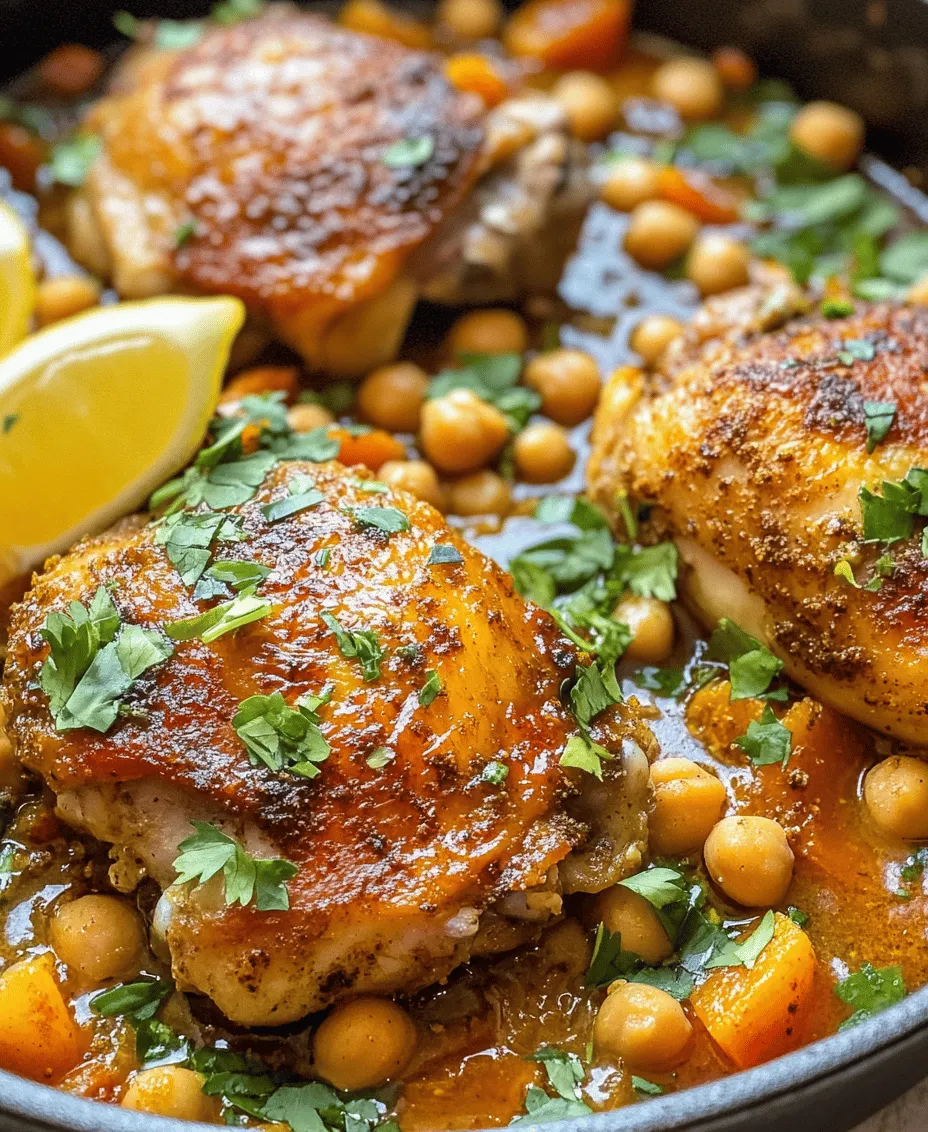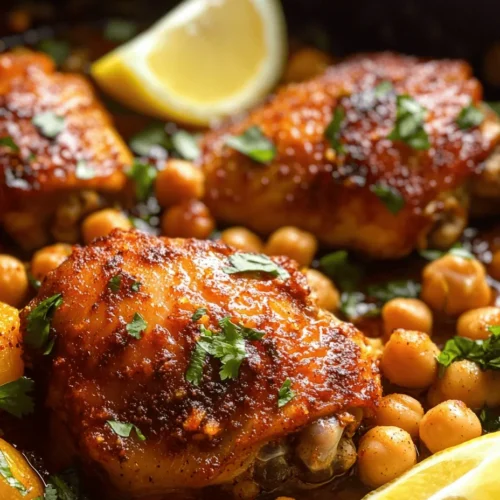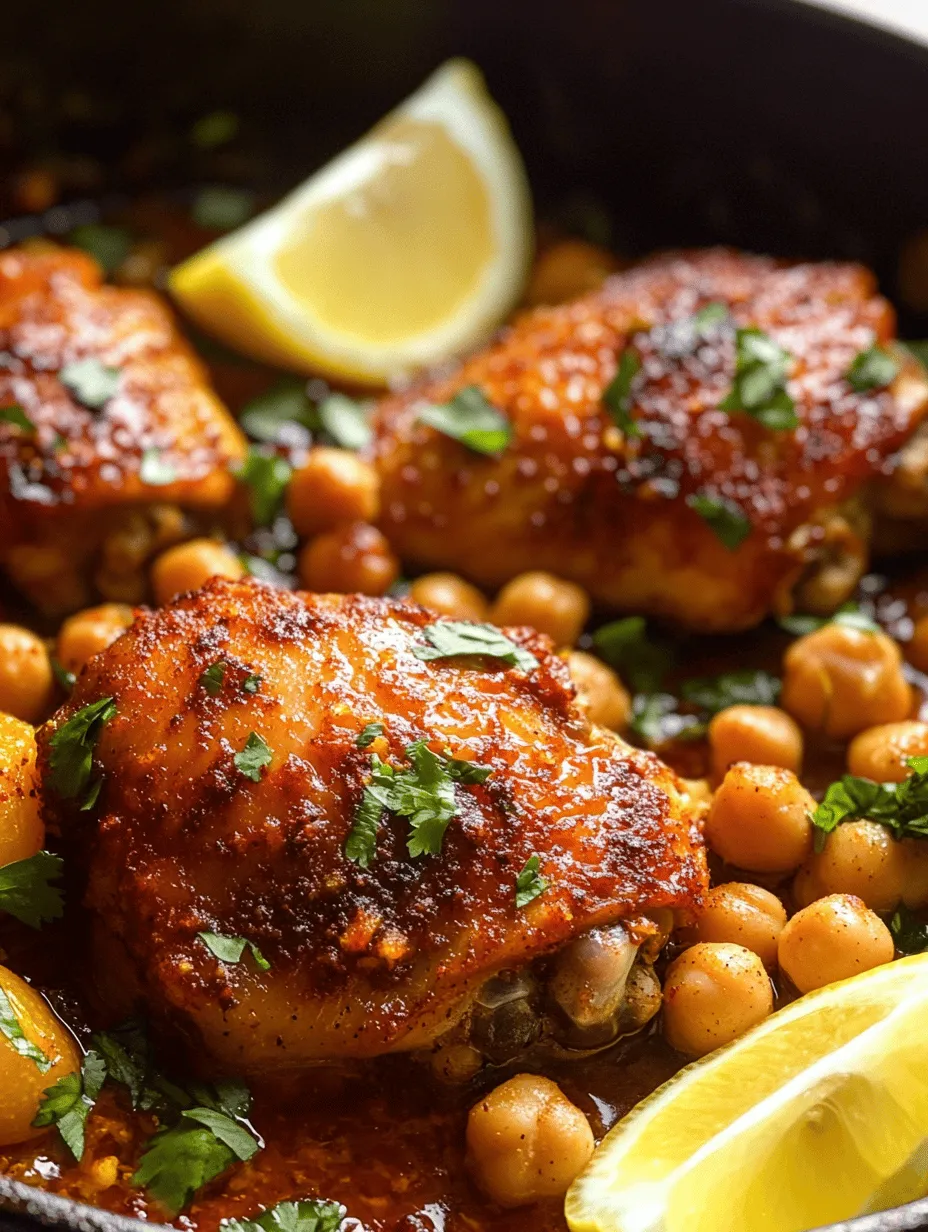Introduction to Moroccan Spiced Chicken
Moroccan cuisine is renowned for its rich and diverse flavors, blending spices and ingredients from various cultures, creating an exquisite tapestry of taste. The vibrant dishes often reflect the country’s history of trade and cultural exchange, where spices like cumin, coriander, and saffron play pivotal roles. One of the standout recipes in this culinary tradition is Moroccan Spiced Chicken, a dish that embodies a delightful fusion of spices, warmth, and comfort.
Moroccan Spiced Chicken is not just a meal; it’s an experience that transports you to the bustling markets of Marrakech or the serene landscapes of the Atlas Mountains. This dish is characterized by its aromatic spice blend, succulent chicken, and the harmony of sweet and savory elements. It serves as a perfect representation of Moroccan cooking, where every bite tells a story of tradition and creativity.
To achieve an authentic Moroccan Spiced Chicken, utilizing quality ingredients and mastering proper techniques is essential. The right blend of spices, fresh herbs, and the perfect cooking method will elevate this dish from ordinary to extraordinary, allowing the flavors to shine through and provide a truly memorable dining experience.
Understanding the Ingredients
The foundation of any great dish lies in its ingredients, and Moroccan Spiced Chicken is no exception. Each component plays a crucial role in defining the overall flavor profile, and understanding these ingredients will help you appreciate the dish even more.
Chicken Thighs: The Heart of the Dish
When it comes to choosing the right chicken for this recipe, bone-in and skin-on chicken thighs are the preferred options. This choice is not merely about preference; it has several advantages. First, the skin adds a layer of richness and flavor that boneless, skinless chicken simply cannot provide. Secondly, chicken thighs are inherently more forgiving than chicken breasts during cooking, retaining moisture and tenderness even when cooked for longer periods.
The bone-in aspect also contributes to the dish’s depth of flavor, as the bones help to enrich the sauce during cooking. When selecting chicken thighs, look for fresh, high-quality meat from a reliable source, as this will significantly impact the final dish.
The Role of Spices
Spices are the soul of Moroccan cuisine, and they play a vital role in creating the complex flavor profile of Moroccan Spiced Chicken. Here’s a breakdown of the key spices that contribute to this dish:
– Ground Cumin and Coriander: These spices provide an earthy base that is essential to the flavor profile. Cumin brings warmth, while coriander adds a hint of citrusy brightness.
– Ground Cinnamon and Turmeric: Cinnamon introduces a subtle sweetness and warmth, complementing the savory elements of the dish. Turmeric not only enhances the flavor but also imparts a beautiful golden hue to the chicken.
– Smoked Paprika and Cayenne Pepper: Smoked paprika adds depth and a slightly sweet, smoky flavor, while cayenne pepper introduces heat, allowing you to customize the spiciness according to your preference.
The Significance of Fresh Ingredients
Fresh ingredients are paramount in Moroccan Spiced Chicken. Ingredients like garlic and lemon serve to brighten and elevate the dish. Garlic contributes a robust flavor, while lemon adds acidity, balancing the richness of the spices and chicken.
Herbs, particularly fresh cilantro or parsley, are often used as a garnish, providing a refreshing contrast against the warm spices. These fresh elements not only enhance the flavor but also bring a visual appeal to the dish.
Dried Apricots and Chickpeas: A Sweet and Savory Pairing
Adding dried apricots and chickpeas to Moroccan Spiced Chicken introduces a delightful interplay of flavors and textures. The apricots contribute a touch of sweetness that complements the spices, while the chickpeas add heartiness and texture, turning the dish into a complete meal. This combination is a hallmark of Moroccan cooking, where sweet and savory coexist harmoniously.
Overview of Cooking Fats: Why Olive Oil is Preferred
When it comes to cooking fats in Moroccan cuisine, olive oil reigns supreme. Not only does it impart a rich flavor to the dish, but it also aligns with the Mediterranean roots of Moroccan cooking. Olive oil is ideal for searing the chicken and sautéing the aromatics, helping to build layers of flavor while keeping the dish healthier compared to other fats.
Marination: The Key to Flavor
One of the most crucial steps in preparing Moroccan Spiced Chicken is marination. This process infuses the chicken with flavors from the spices, allowing them to penetrate the meat and enhance its tenderness. Marinating the chicken not only adds depth but also ensures that each bite is bursting with flavor.
Preparing the Spice Rub
To create the spice rub for marination, start by combining the ground spices in a bowl. Here’s a simple recipe for the spice rub:
– 2 teaspoons ground cumin
– 2 teaspoons ground coriander
– 1 teaspoon ground cinnamon
– 1 teaspoon turmeric
– 1 teaspoon smoked paprika
– ½ teaspoon cayenne pepper (adjust according to your heat preference)
– Salt and black pepper to taste
Mix these spices thoroughly, and then add minced garlic, freshly squeezed lemon juice, and a generous drizzle of olive oil to form a paste. This paste will cling to the chicken, creating a flavorful crust during cooking.
Recommended Marination Times and Techniques
For optimal flavor infusion, marinate the chicken thighs for at least 1 hour, but ideally, you should aim for 4 hours or even overnight. If you’re in a hurry, a shorter marination time can still yield good results, but the longer you allow the chicken to soak up the flavors, the more pronounced they will be.
To marinate, simply coat the chicken thighs in the spice paste, ensuring an even distribution. Place the chicken in a resealable plastic bag or a shallow dish, cover it, and refrigerate. This allows the flavors to meld beautifully while the chicken absorbs the aromatic spices.
How Marination Enhances Flavor and Tenderness
Marination is a transformative process that not only enhances flavor but also improves the texture of the chicken. The acids from the lemon juice help to break down the proteins in the meat, resulting in a tender and juicy final product. Additionally, the spices work their way into the chicken, ensuring that every bite is flavorful and satisfying.
Searing and Sautéing: Building Flavor Layers
Once the chicken has marinated, the next step is to build layers of flavor through searing and sautéing. This technique is fundamental in creating a rich and complex base for the dish.
The Searing Process and Its Benefits
Searing the chicken thighs in a hot skillet creates a beautiful brown crust, which not only enhances the visual appeal of the dish but also adds depth of flavor. The Maillard reaction, which occurs when proteins are exposed to high heat, produces a range of savory compounds that contribute to the overall taste.
To properly sear chicken, heat a couple of tablespoons of olive oil in an oven-safe skillet over medium-high heat. Once the oil is shimmering, carefully place the marinated chicken thighs in the pan, skin-side down. Allow them to cook undisturbed for about 5-7 minutes until the skin is golden brown and crispy.
Importance of Using an Oven-Safe Skillet
Using an oven-safe skillet is crucial for this recipe, as it allows for a seamless transition from stovetop to oven. After searing both sides of the chicken, you can add the sautéed aromatics and any additional ingredients directly into the same skillet, making cleanup easier and retaining all the delicious flavors.
Sautéing Onions and Garlic: Step-by-Step Guidance
Once the chicken is seared, remove it from the skillet temporarily and set it aside. In the same skillet, add diced onions along with a pinch of salt. Sauté the onions for about 3-4 minutes until they start to soften and become translucent. Next, add minced garlic and sauté for an additional 30 seconds until fragrant.
This step is essential as it builds a flavorful base for the sauce that will envelop the chicken. The sweet, caramelized onions and aromatic garlic will enhance the overall richness of the dish, setting the stage for the spices to shine.
How the Sautéing Process Contributes to the Overall Depth of Flavor
The sautéing process not only adds layers of flavor but also allows for the chicken drippings to meld with the onions and garlic. As the onions release their sweetness and the garlic imparts its aromatic qualities, these elements combine with the remnants of the seared chicken, creating a robust backdrop for the final dish.
By understanding the importance of each ingredient and technique—marinating, searing, and sautéing—you are well on your way to creating a delicious Moroccan Spiced Chicken. In the next part of this article, we will continue our journey, exploring the final cooking techniques and presentation tips to elevate your dish to new heights.

Combining Ingredients: Creating the Perfect Sauce
Crafting a flavorful sauce is essential for the Moroccan Spiced Chicken recipe. Begin by simmering the dried apricots, honey, and chicken broth in a medium saucepan. This step is crucial as it allows the apricots to soften and infuse their natural sweetness into the broth while the honey lends a rich, caramelized flavor.
To achieve the right balance of sweetness and acidity, consider adding a splash of freshly squeezed lemon juice or a dash of vinegar. This acidity will help cut through the sweetness of the apricots and honey, creating a harmonious flavor profile. Taste your sauce as it simmers and adjust the acidity to your liking; you may also want to incorporate a pinch of salt to enhance the overall taste.
Layering flavors is key before roasting the chicken. After the sauce has thickened slightly and the apricots have softened, pour it over the marinated chicken in your roasting pan. This step not only adds moisture during cooking but also allows the chicken to absorb the aromatic spices and sweet-sour notes of the sauce as it roasts. Make sure each piece of chicken is well-coated for maximum flavor.
Roasting: Achieving Perfectly Cooked Chicken
Roasting is a fundamental technique that transforms your marinated chicken into a succulent, flavorful dish. Preheat your oven to 375°F (190°C) for an even roast. The chicken should be placed in the center of the oven to ensure even heat distribution. This method allows the chicken to cook through while developing a golden-brown crust on the outside.
The optimal cooking time for chicken thighs is generally between 35 to 45 minutes, depending on their size. To ensure juicy and tender chicken, use a meat thermometer to check for doneness. The internal temperature should reach at least 165°F (74°C). If you find that the chicken is browning too quickly, you can cover it loosely with aluminum foil to prevent burning while it continues to cook through.
Understanding doneness is essential in achieving the perfect chicken. In addition to checking the internal temperature, you can also look for juices running clear when you pierce the thickest part of the chicken. If the juices are pink, the chicken requires more cooking time.
Plating and Presentation: Making It Visually Appealing
Once your Moroccan Spiced Chicken is perfectly roasted, it’s time to focus on plating and presentation. Start by transferring the chicken pieces to a large serving platter. Drizzle some of the sauce from the roasting pan over the chicken for added moisture and flavor.
Garnishing your dish with fresh herbs like cilantro or parsley and a sprinkle of lemon zest can elevate its visual appeal. The vibrant green of the herbs and the bright yellow zest not only provide a contrast in color but also enhance the aromatic experience of the dish.
When it comes to serving suggestions, consider pairing your Moroccan Spiced Chicken with traditional sides such as fluffy couscous, fragrant rice, or roasted vegetables. Chickpeas can also be added to the dish to enhance both texture and nutritional value. The combination of flavors and textures will create a more fulfilling dining experience.
Remember, presentation enhances the overall experience of the meal. Take a moment to arrange the chicken artfully on the platter, adding sides in a way that complements the main dish. The more visually appealing your meal, the more enticing it will be to your guests.
Nutritional Value of Moroccan Spiced Chicken
Moroccan Spiced Chicken is not only delicious but also packed with nutritional benefits. The main ingredients in this dish contribute to a well-rounded meal. Chicken is an excellent source of lean protein, which is vital for muscle repair and growth. It is low in fat, particularly when using skinless cuts, making it a healthy choice for a balanced diet.
Chickpeas, often used in Moroccan cuisine, provide a hearty source of fiber, which aids in digestion and promotes a feeling of fullness. They are also rich in protein and essential nutrients like iron, magnesium, and B vitamins. This combination of chicken and chickpeas makes for a nutrient-dense meal that supports overall health.
The spices used in this recipe, such as cumin, coriander, and cinnamon, not only contribute to the flavor but also possess health benefits. Many spices are known for their anti-inflammatory properties, which can help combat chronic diseases. For example, cumin is believed to aid digestion, while cinnamon may help regulate blood sugar levels.
Cultural Significance of Moroccan Spiced Chicken
Moroccan Spiced Chicken reflects the rich culinary traditions of Morocco, a country known for its vibrant flavors and aromatic spices. Moroccan cuisine is a melting pot of influences from Berber, Arab, and Mediterranean cultures, resulting in a unique gastronomic experience.
This dish embodies the essence of Moroccan cooking, where spices play a central role in flavoring. The use of sweet and savory ingredients is a hallmark of Moroccan dishes, often illustrating the balance between contrasting flavors. Moroccan meals are traditionally served family-style, encouraging communal dining and connection among loved ones.
In various regions of Morocco, you may find variations of this dish, with some using different spices or incorporating additional vegetables. For instance, in coastal areas, seafood may be a popular substitute for chicken, while inland regions might favor lamb or beef. The beauty of Moroccan cuisine lies in its diversity, with each region adding its twist to traditional recipes.
Conclusion: Embracing the Flavors of Morocco
Moroccan Spiced Chicken is a magnificent dish that encapsulates the unique flavors and vibrant culture of Morocco. The combination of aromatic spices, sweet apricots, and tender chicken creates a meal that is not only satisfying but also a journey through culinary history.
By trying this recipe, you are not just cooking a meal; you are embracing a rich tradition and bringing the essence of Moroccan dining into your home. Whether you’re hosting a dinner party or enjoying a cozy meal with family, this dish is sure to impress and delight.
As you embark on your cooking adventure, remember the joy of creating and sharing meals with loved ones. The experience of preparing Moroccan Spiced Chicken is as much about the flavors as it is about the moments spent around the table, sharing stories, laughter, and love. So gather your ingredients, embrace the spices, and let the aromatic journey of Moroccan cuisine fill your home with warmth and joy.



